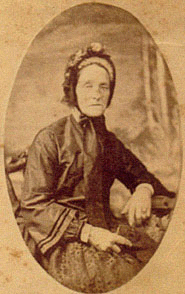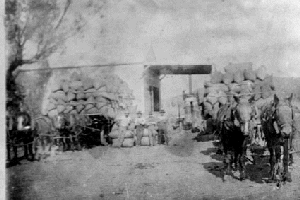Reminiscences from:
GEORGE CHARLES STUDD
George was born in 1828 at Wivenhoe, Essex and baptised at St
Mary the Virgin Church of England.
He was indentured on 4 June 1844, for four years, to R. Lee of Newcastle
to serve his mariner’s apprenticeship on the ‘Scipio’.
On 3 February 1853, he was part of the crew under Captain K. Eagle, on
the emigrant ship ‘Calliope’ when it left Southampton.
The ship was registered in London, weighed 769 tons and had 380 on board.
It arrived in Melbourne on 18 May 1853 and by that stage he had formed
a relationship with one of the emigrants, Victoria Isabella, and the rest
is history.
 VICTORIA ISABELLA SPURGEON
VICTORIA ISABELLA SPURGEON
Victoria was baptised 30 July 1837 at St Andrew’s Holborn Church
of England London, UK. Her father was James, a farrier, born around 1811
in Essex or Middlesex, and his parents were James and Hannah.
Her mother was Elizabeth Sarah Davy, born around 1810 at Long Acre, St
Martin-Le-Grand, London, and her parents were William Davy and Sarah (nee
Hopkins), who married at St Martin-in-the-Fields, Westminster.
GEORGE AND VICTORIA STUDD
After 1851, the gold rush in Victoria saw thousands of people arrive in Melbourne and move into central and western districts, following each new strike. In many cases, families settled, developing towns and taking up land for farming.
George and Victoria were typical of the times, marrying on 16th August
1853 at St Peter’s Church of England, Eastern Hill, Melbourne. Her
father (James Spurgeon) signed the marriage certificate and George signed
his name and Victoria’s name.
They were living in Wellington St Collingwood (Melbourne) at the time
of their wedding. Isabella wore the dress she had made and which is still
cared for by one of the descendants.
The Amphitheatre diggings had started in 1853. In 1865 the Government
allowed Crown Land to be sold and in this way the town began to take shape
at the junction of the Amphitheatre Creek and Avoca River. The area is
also known Glenlogie.
Also in the 1860’s, the Government established a number of Land Acts, which enabled people to select, lease or buy land. I have yet to research when George Charles bought his allotments in the Amphitheatre / Greenhill Creek area and under which method.
The family was living in Amphitheatre by Oct 14 1863 because George Charles
(a miner of Amphitheatre) was a witness at the inquest of J. Edmonds
Their ten children were:
(1) James Charles Gibb, born 24th
May 1854 at Prahran (Melbourne) On the certificate, George Charles is
described as a labourer and Victoria made her ‘mark’. This
is also the first time Victoria’s name is written as Vittoria. James
married Mary Jane Innes in 1885 at Buninyong (Victoria) and they had 5
children (Charles George, Frederick Arthur, Ellen Florence, William Henry,
Leslie Edward)
(2) George William Charles, born in
1856, was never registered. The family at that time, were living at Raglan
(between Amphitheatre and Beaufort). This area was known as the Fiery
Creek diggings. George married Johanna Blanche in 1886 and they had 9
children. (James, George William, Victoria Spurgeon, Andrew, Julia Elizabeth,
Blanche Elsie, Herbert, Alexander,
William)
(3) Elizabeth Ann, was born 27th July 1858 at Cochrans Creek (north of Dunolly) where George Charles was a ‘digger’ (miner). She married George Goldsmith on 31 December, 1873 at Amphitheatre and they had 11 children. Philip, James, Alice Victoria, John Edward, Eleanor Sarah, Lucy Elizabeth, George Henry, Arthur Leslie, William Robert, Frederick Charles, Stella Jane)
(4) Arthur Robert, was born at Lamplough (a few kilometres south of Avoca, on the Lexton Road) , on 21st June 1860, seven months after the Lamplough gold rush started. George Charles was a miner. Arthur didn’t like this name and was always known as Robert Arthur. He married Catherine Jane Elizabeth Blake on 29th July 1882 at Horsham (Victoria) and they had 7 children (Alice Victoria, Jane Margaret Amelia, Frederick Henry, Katie, Charles Blake, Mary Elizabeth, Nellie Bedelia).
 This photo, taken in the 1920's, shows Robert Arthur Studd
(fourth child of
George and Victoria) at his property with his two sons (Frederick Henry
and
Charles Blake) and his son-in law (William Simon Fraser) getting the wheat
harvest bagged and loaded for its trip to the Boggabri silos. Each had
his
own farm in the same district, but at harvest time, everyone got together
to
help each other.
This photo, taken in the 1920's, shows Robert Arthur Studd
(fourth child of
George and Victoria) at his property with his two sons (Frederick Henry
and
Charles Blake) and his son-in law (William Simon Fraser) getting the wheat
harvest bagged and loaded for its trip to the Boggabri silos. Each had
his
own farm in the same district, but at harvest time, everyone got together
to
help each other.
(5) Alice Amelia was born 23rd December 1862, at No1 Creek, (halfway between Avoca and Amphitheatre), where George Charles was a miner. She married firstly George Richard Voas on 16th July 1887 at Fitzroy (Melbourne), having 2 children (Alice Victoria, Agnes Maud) She married secondly Henry Thompson in 1892, having another 2 children (Ernest Henry, Lucy Alice).
(6) Henry was born on 26th May 1865, the family were living at Amphitheatre and George Charles was a miner. He married a widow, Sophia Mary Gibbings (nee Hancock) in Bunbury, Western Australia, on 30th January 1902. They had no children.
(7) Frederick was born 2nd Feb 1868, the family living at Amphitheatre where George Charles was a miner. He married May Woolley in Perth (Western Australia) on 16th Oct 1907 and they had one child (Thelma May)
(8) Edward Studd was born 19th June
1870 at Amphitheatre. Nothing
more is known about him
(9) Walter Studd born
11th April 1873 at Amphitheatre, where
George Charles calls himself a labourer. He married Sarah Hannah Bold
on 7
June 1891 and they had 7 children (Lesley Walter, Marion Vera, Harry James,
Ada Mary, Edward, Arthur Stanley, Thomas Frederick).
(10) Willie Spurgeon Studd born
20 September, 1876 at Amphitheatre.
He married Marion Helen Comins in Wellington, New Zealand, on 30 January
1906 and they had three children (Arthur Edward, George Charles and Richard
Henry).
George Charles Studd was listed as a miner
in Bailliere's Post Office
Directory of 1868.There was an unclaimed letter for George Charles Studd,
dated 15 February 1860 at Lamplough Post Office.
He was a witness at the inquest on Margaret Clegg, 30 April 1884 at Avoca.
On 6 October 1884, described as a labourer of Amphitheatre, he was admitted
to Maryborough Hospital, suffering from phthisis (a common miner's disease
similar to TB) He died on 23 October 1884 and was buried at the
Glenlogie/Amphitheatre cemetery. George Goldsmith (Elizabeth Ann's husband)
signed as a witness
These ten children of the first generation produced forty five children in the second generation, one hundred and fifteen in the third generation and we now have six generations of descendants, in Australia, New Zealand and the USA.
Bibliography:
Beavis, Margery & Betty. Pioneers Of The Pyrenees,
The Hamilton Spectator
Hamilton, Victoria, 1984
Oulton, Margaret. A Valley Of The Finest Description – A History
Of The Shire Of Lexton. Australian Print Group, Maryborough, Victoria,
3rd edition, 1995